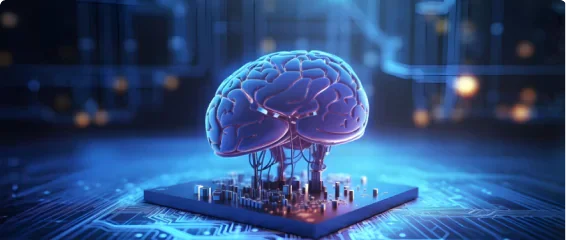Machine Learning and AI for revolution of Tech Companies are changing and streamlining businesses.
Intelligent automation, the combination of artificial intelligence (AI) and automation technologies, is revolutionizing industries across the globe.
In today’s modern-age world, it has become crucial for organizations to maintain a competitive edge by staying updated with the latest Intelligent Automation trends.
In this blog post, we will learn about the top 10 trends in intelligent automation to look out for in 2023 and understand their potential impact on businesses.
From the integration of cutting-edge artificial intelligence to the expansion of human-machine collaboration, the year 2023 brings a slew of transformative trends set to redefine how organizations function.
Below are the top 10 Trends in Intelligent Automation.
Top 10 intelligent automation trends
These top ten trends, from enhanced AI capabilities to new ways of human-AI collaboration, are poised to impact organizations across industries.
Trend #1: AI-powered intelligent automation
With advancements in machine learning and natural language processing, AI-powered automation systems can analyze vast amounts of data, identify patterns, and make intelligent decisions.
The trend of artificial intelligence solutions within intelligent automation is poised to continue its growth in sophistication and integration throughout automation workflows.
The benefits of AI in intelligent automation include improved accuracy, enhanced decision-making capabilities, and increased operational efficiency.
Trend #2: Hyperautomation
Hyperautomation refers to the comprehensive automation of business processes by combining robotic process automation (RPA) with AI, machine learning, and other advanced technologies.
In 2023, hyper-automation will gain traction as organizations seek end-to-end automation solutions.
By automating complex workflows and integrating disparate systems, hyper-automation can optimize business processes, minimize errors, and improve overall productivity.
Trend #3: Process mining
By capturing and visualizing process data, organizations can identify restrictions, inefficiencies, and areas for improvement.
In 2023, process mining will play a crucial role in intelligent automation by providing valuable data-driven insights to drive process optimization and automation initiatives.
The benefits of using process mining in intelligent automation include improved process efficiency, reduced costs, and enhanced customer satisfaction.
Trend #4: Low-code/No-code platforms
These platforms enable users with little to no coding experience to create automation workflows using visual interfaces and pre-built components.
In 2023, the adoption of low-code/no-code platforms is expected to rise as organizations seek to democratize automation and empower citizen developers.
The benefits of using low-code/no-code platforms include faster development cycles, increased agility, and reduced dependence on IT resources.
Trend #5: Cloud-based automation
In 2023, cloud-based automation will continue to gain popularity due to its flexibility, scalability, and accessibility.
Organizations can leverage cloud-based automation platforms to deploy and manage automation workflows across geographically dispersed teams.
The latest developments in cloud-based automation technology include serverless computing, which eliminates the need for infrastructure management and enables organizations to focus on Intelligent Automation Innovations and business outcomes.
Trend #6: Intelligent document processing (IDP)
IDP combines AI technologies such as optical character recognition (OCR), natural language processing (NLP), and machine learning to automate document ingestion, classification, extraction, and validation.
In 2023, IDP will continue to evolve, enabling organizations to streamline document-intensive processes such as invoice processing, contract management, and compliance documentation.
The benefits of IDP include increased accuracy, faster processing times, and improved data quality.
Trend #7: Chatbots and virtual assistants
Chatbots and virtual assistants like chat gpt app have become all over the place in customer service and support functions.
Powered by AI technologies such as natural language understanding (NLU) and sentiment analysis, these conversational agents can provide personalized assistance, answer queries, and resolve issues around the clock.
In 2023, chatbots and virtual assistants will continue evolving with voice recognition and emotional intelligence advancements.
Trend #8: Automation for remote workforce
In 2023, intelligent automation will be crucial in supporting remote workforce operations.
Organizations can leverage automation technologies to enable employees to work remotely while maintaining productivity and collaboration.
From virtual collaboration tools to automated task allocation systems, the latest app developments in AI technology for the remote workforce enable seamless remote operations, efficient resource management, and enhanced employee engagement.
Trend #9: Human-centered automation
Human-centered automation focuses on augmenting human capabilities rather than replacing them.
Human-centered automation ensures that employees are involved in designing and implementing automation workflows, allowing them to focus on higher-value tasks. At the same time, machines handle repetitive and mundane activities.
The benefits of human-centered automation include increased job satisfaction, improved employee morale, and higher productivity.
Trend #10: Intelligent automation ethics
In 2023, organizations will increasingly focus on ensuring responsible and ethical use of automation technologies.
This includes addressing concerns related to data privacy, bias in AI algorithms, transparency in decision-making processes, and the impact of automation on jobs and society.
The latest developments in intelligent automation ethics involve the development of ethical frameworks, guidelines, and regulations to ensure that automation technologies are used for the benefit of humanity.
Benefits of intelligent automation
Intelligent automation in 2023 offers numerous benefits across various industries and functions. Here are some of the key Benefits of Intelligent Automation:
- Increased Efficiency: Intelligent automation Strategies combine artificial intelligence (AI) and automation to streamline processes, reducing manual effort and operational costs. Tasks that previously required human intervention can be completed faster and more accurately.
- Enhanced Productivity: With routine and repetitive tasks automated, employees can focus on more creative, strategic, and high-value activities, leading to increased overall productivity.
- Cost Savings: By automating tasks, organizations can reduce labor costs, minimize errors, and optimize resource allocation, leading to significant cost savings in the long run.
- Improved Accuracy: AI-driven automation systems are less prone to errors and can consistently perform tasks with high accuracy, reducing the risk of costly mistakes.
- Faster Decision-Making: Intelligent automation processes data rapidly and can provide real-time insights, enabling organizations to make quicker and more informed decisions.
- Enhanced Customer Experience: Automation can be applied to customer service functions, providing faster response times, 24/7 availability, and personalized interactions, improving customer satisfaction.
- Scalability: Intelligent automation can quickly adapt to changes in workload and demand, making it scalable for growing and fluctuating business needs.
- Compliance and Risk Management: Automation helps ensure that processes and transactions adhere to regulatory and compliance requirements, reducing the risk of non-compliance and associated penalties.
- Data Analysis and Insights: AI-powered automation can process and analyze vast amounts of data, extracting valuable insights to inform strategic decisions and drive innovation.
- Competitive Advantage: Organizations that adopt intelligent automation can gain a competitive edge by delivering products and services more efficiently and effectively than their competitors.
- Employee Satisfaction: Employees appreciate automation for handling mundane and repetitive tasks, allowing them to focus on more challenging and fulfilling aspects of their roles, boosting morale and job satisfaction.
- Resource Allocation: Automation tools can help organizations allocate resources more effectively, optimizing staffing levels, equipment usage, and inventory management.
- Predictive Maintenance: In manufacturing and service industries, predictive maintenance powered by AI can reduce downtime and extend the lifespan of equipment, saving on maintenance costs.
- Supply Chain Optimization: Intelligent automation can optimize supply chain operations by improving demand forecasting, inventory management, and logistics, reducing costs and faster delivery times.
- Environmental Impact: Through better resource management and optimization, intelligent automation can contribute to sustainability by reducing energy consumption, waste, and carbon emissions.
- Adaptation to Market Changes: Automation allows organizations to respond quickly to changes in market conditions, making it easier to pivot and adapt to evolving customer preferences and market trends.
In 2023, the adoption of intelligent automation continues to grow across industries, offering these and many other benefits to organizations looking to enhance their operational efficiency, agility, and competitiveness in an increasingly digital and data-driven world.
How do these trends impact organizations?
In 2023, the landscape of intelligent automation is evolving at an extraordinary pace, bringing with it a wave of transformative trends that have the potential to revolutionize how organizations operate.
AI-driven chatbots and virtual assistants, for instance, are becoming even more sophisticated, improving customer interactions and streamlining support services.
Additionally, integrating robotic process automation (RPA) with AI-Powered Process Automation leads to more autonomous decision-making and task execution, resulting in increased efficiency and cost savings.
With these trends, organizations can enhance productivity, reduce costs, improve customer experiences, and gain a competitive edge in an increasingly automated world.
Conclusion
2023 promises to be an exciting year for intelligent automation.
Embracing AI-Powered Process Automation is not just a choice but a necessity for businesses looking to thrive in the digital age.
So, keep an eye on these trends and prepare your organization for a future powered by intelligent Automation Strategies!
Frequently asked questions
With advanced technology, intelligence automation will lead to increased efficiency, enhanced productivity, savings in cost, and improved customer experiences.
Some of the best tools include UiPath, Automation Anywhere, Blue Prism, and Pega Systems.
AI algorithms are used to analyze data, make decisions, and perform cognitive tasks, while RPA technology enables the automation of rule-based, repetitive tasks.
Intelligent automation reduces the need for manual labor, freeing up employees to focus on more value-added tasks. Intelligent automation saves cost and time by enhancing scalability and flexibility.
There are different types of intelligent automation, such as Robotic Process Automation (RPA), Cognitive Automation, Chatbots, Business Process Automation, and Intelligent Document Processing.









